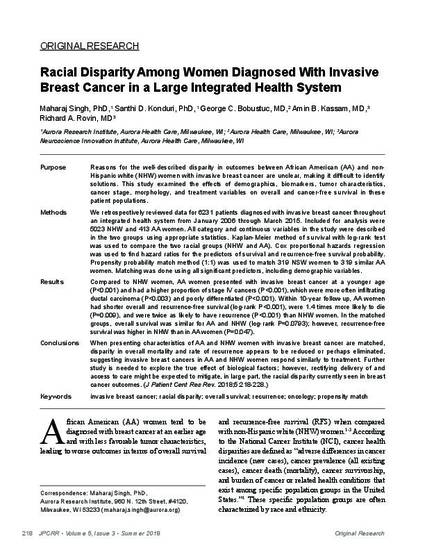
- invasive breast cancer,
- racial disparity,
- overall survival,
- recurrence,
- oncology,
- propensity match
Purpose: Reasons for the well-described disparity in outcomes between African American (AA) and non-Hispanic white (NHW) women with invasive breast cancer are unclear, making it difficult to identify solutions. This study examined the effects of demographics, biomarkers, tumor characteristics, cancer stage, morphology, and treatment variables on overall and cancer-free survival in these patient populations.
Methods: We retrospectively reviewed data for 6231 patients diagnosed with invasive breast cancer throughout an integrated health system from January 2006 through March 2015. Included for analysis were 5023 NHW and 413 AA women. All category and continuous variables in the study were described in the two groups using appropriate statistics. Kaplan-Meier method of survival with log-rank test was used to compare the two racial groups (NHW and AA). Cox proportional hazards regression was used to find hazard ratios for the predictors of survival and recurrence-free survival probability. Propensity probability match method (1:1) was used to match 319 NSW women to 319 similar AA women. Matching was done using all significant predictors, including demographic variables.
Results: Compared to NHW women, AA women presented with invasive breast cancer at a younger age (P < 0.001) and had a higher proportion of stage IV cancers (P < 0.001), which were more often infiltrating ductal carcinoma (P < 0.003) and poorly differentiated (P < 0.001). Within 10-year follow-up, AA women had shorter overall and recurrence-free survival (log-rank P < 0.001), were 1.4 times more likely to die (P = 0.009), and were twice as likely to have recurrence (P < 0.001) than NHW women. In the matched groups, overall survival was similar for AA and NHW (log-rank P = 0.0793); however, recurrence-free survival was higher in NHW than in AA women (P = 0.047).
Conclusions: When presenting characteristics of AA and NHW women with invasive breast cancer are matched, disparity in overall mortality and rate of recurrence appears to be reduced or perhaps eliminated, suggesting invasive breast cancers in AA and NHW women respond similarly to treatment. Further study is needed to explore the true effect of biological factors; however, rectifying delivery of and access to care might be expected to mitigate, in large part, the racial disparity currently seen in breast cancer outcomes.
Singh M, Konduri SD, Bobustuc GC, Kassam AB, Rovin RA. Racial disparity among women diagnosed with invasive breast cancer in a large integrated health system. J Patient Cent Res Rev. 2018;5:218-28. doi: 10.17294/2330-0698.1621
